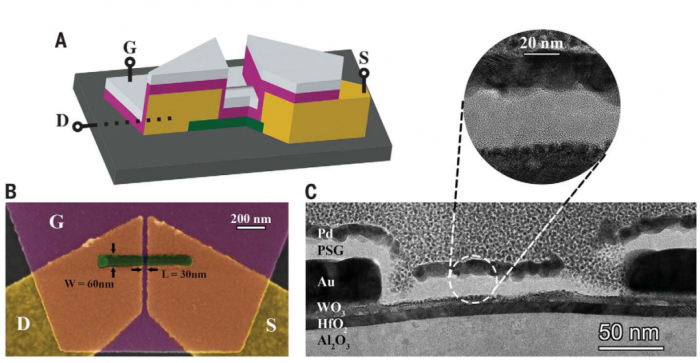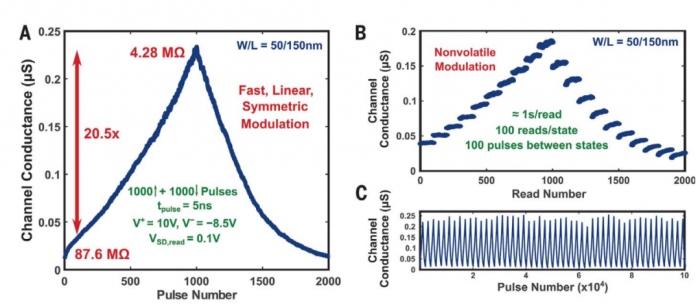More recently, a new field of artificial intelligence known as “analog deep learning” promises faster computing with less energy. Programmable resistors are a key part of analog deep learning, just as transistors are the core elements of digital processors.
By repeatedly arranging programmable resistors in complex layers, the researchers can create a network of simulated artificial neurons and synapses that perform computations just like a digital neural network. This network can be trained to implement complex AI tasks such as image recognition and natural language processing.
picture
The computational speed of simulating a neural network is largely determined by the transmission speed of the “artificial synapse”. That’s what a team at MIT has to tackle. They have developed an artificial analog synapse before, and what they have to do now is to create a new material that surpasses the old version.
This time, they made use of a practical inorganic material in the fabrication process, allowing the aforementioned programmable resistors to operate a million times faster than previous versions, while also achieving synapses faster than those found in the human brain. About a million times faster. In addition, the material makes the resistor extremely energy efficient. Unlike the materials used in earlier versions of the device, the new materials are compatible with silicon fabrication techniques. This change makes it possible to fabricate devices at the nanoscale and may pave the way for integration into commercial computing hardware for deep learning applications. The research paper has been published in Science.
picture

Paper link: https://www.science.org/doi/pdf/10.1126/science.abp8064
“With this key discovery, coupled with MIT.nano’s powerful nanofabrication technology, we have Being able to put these pieces together and show that these devices are inherently very fast and can operate at reasonable voltages.” “The device works by electrochemically inserting the smallest ions — protons — into insulating oxides. in order to tune its electronic conductivity. Because the device we used is very thin, it is possible to accelerate the motion of this ion by using a strong electric field and push these ion devices to nanosecond operation.” Corresponding author of the paper, Nuclear Science and Engineering explained Bilge Yildiz, the Breene M. Kerr Professor in the Department of Materials Science and Engineering. Corresponding author Ju Li, professor of nuclear science and engineering and professor of materials science and engineering at Battelle Energy Alliance, said:
“Action potentials in biological cells rise and fall on a millisecond scale because a voltage difference of about 0.1 volts is subject to the stability of water.” Here, we apply up to 10 volts to a special nanometer-thick film of solid glass voltage, the membrane can conduct protons without permanently damaging it. Also, the stronger the electric field, the faster the ion device operates. Co-authors on the paper also include Frances M. Ross, the Ellen Swallow Richards Professor in the Department of Materials Science and Engineering; postdocs Nicolas Emond and Baoming Wang; and EECS graduate student Difei Zhang.
These programmable resistors greatly increase the training speed of neural networks, while greatly reducing the cost and energy consumption of training. This could help scientists develop deep learning models faster for applications such as self-driving cars, fraud detection or medical image analysis. “Once you have an analog processor, you don’t have to train the networks that other people are working on. You can train networks with unprecedented levels of complexity that no one else can afford. In other words, it’s not only Just a fast car, but a plane.” said Murat Onen, first author of the paper and a postdoc at MIT.
1 million times faster deep learning
There are two main reasons why analog deep learning is faster and more energy efficient than its digital counterpart.
First, the computation is done in memory, so huge data loads don’t travel back and forth from memory to the processor. The analog processors also operate in parallel. If the matrix is enlarged, the analog processor does not need more time to complete the new operation because all computations are performed simultaneously. A key element of MIT’s new analog processor technology is called a proton programmable resistor. These resistors are measured in nanometers and arranged in an array, like a checkerboard. picture
Nanosecond Proton Programmable Resistors
To develop an ultrafast, energy-efficient programmable proton resistance, the researchers looked for different electrolyte materials. While other devices use organic compounds, Onen is focusing on inorganic phosphosilicate glass (PSG). PSG is basically silica, a powdered desiccant material used to remove moisture.
Under humidified conditions, the researchers studied it as a proton conductor for fuel cells. It is also the most well-known oxide in silicon processing. To make PSG, a small amount of phosphorus is added to silicon, which gives it the special property of proton conduction. Onen hypothesized that the optimized PSG could have high proton conductivity at room temperature without the need for water, which would make it an ideal solid electrolyte.
Amazing speed
PSG enables the ultrafast motion of protons because it contains a large number of nanometer-sized pores whose surfaces provide pathways for proton diffusion.
It can also withstand very strong pulsed electric fields.
“This is critical because applying more voltage to the device can make the protons move extremely fast,” explains Onen.

“The speed is quite surprising,” Onen said. “Normally, we wouldn’t use such a strong magnetic field on devices to keep them from turning to ashes. But instead, the protons ended up zipping through the stack of devices at enormous speeds, And it’s still a million times faster than what we were before. Plus, because of the proton’s small size and low mass, this motion doesn’t break anything. It’s almost like teleportation.”
Because the protons don’t damage the material, the resistor can run for millions of cycles without failure.
picture
Ultrafast and Energy Efficient Modulation Properties of Proton Programmable Resistors
The new electrolyte makes programmable proton resistors a million times faster than previous devices and can operate efficiently at room temperature, which is important for their incorporation into computing hardware.
Due to the insulating properties of PSGs, there is little current through the material as the protons move. “This makes the device very energy efficient,” Onen added.
“Now that they’ve demonstrated the effectiveness of these programmable resistors, the researchers plan to redesign them for high-volume production,” del Alamo said. “They can then study the properties of the resistor array and scale it up so that they can It’s embedded in the system.”
Yildiz added: “Another exciting direction these ionic devices can enable is energy-efficient hardware to simulate neural circuits and synaptic plasticity rules derived in neuroscience, going beyond simulating deep neural networks. We have already started working with neuroscience. Such collaborations are supported by the MIT Quest for Intelligence.”
picture
Del Alamo said: “Our collaboration is essential for future innovation. The road ahead remains challenging, but at the same time very exciting!”
“Intercalation reactions such as those found in lithium-ion batteries have been widely explored in memory devices,” said William Chueh, associate professor of materials science and engineering at Stanford University. “This work shows that proton-based memory devices offer impressive and Amazing switching speed and durability.”
William Chueh, however, was not involved in the study.




GIPHY App Key not set. Please check settings